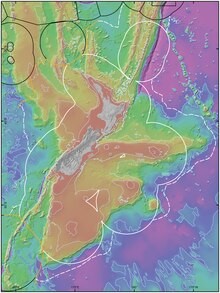Blog Credit: Trupti Thakur
Image Courtesy: Google
Zealandia
A dedicated team of international geologists and seismologists has embarked on a mission to chart the depths of Zealandia, a relatively unknown landmass submerged beneath the Pacific Ocean. Their efforts have resulted in the creation of an updated and highly detailed map that sheds light on the continent’s intriguing geological features.
Where in the World is Zealandia?
Zealandia, often referred to as the eighth continent, remains shrouded in oceanic mystery, with a staggering 94% of its expanse concealed beneath the sea’s surface. The remaining 6% peeks above the waves, encompassing islands such as New Zealand and its neighboring isles.
The geological history of Zealandia dates back approximately 83 million years when volcanic forces played a pivotal role in separating the supercontinent Gondwana, giving rise to the continents we recognize today.
Creating the refined map of Zealandia was no small feat. The research team embarked on a comprehensive journey, utilizing an array of methodologies to illuminate this submerged realm. Here’s how they did it:
- Oceanic Rock Samples and Sediments
To refine the existing maps, the scientists meticulously examined rock samples and sediment specimens collected from the ocean floor. These valuable materials were acquired through drilling operations and coastal expeditions within the region.
- Seismic Data Analysis
The research journey extended beyond rock samples. The team delved into seismic data gathered from the Zealandia area, further enhancing their understanding of its geological makeup.
- Mapping the Entire Continent
With these essential resources at their disposal, the scientists embarked on the monumental task of mapping Zealandia in unprecedented detail. This submerged continent spans a vast 5 million square kilometers.
Unlocking Geological Secrets
The examination of the samples uncovered intriguing geological patterns in Western Antarctica, hinting at the presence of a potential subduction zone near Campbell Plateau on New Zealand’s western coast. Despite this revelation, magnetic anomalies in the region did not disprove theories of a strike-slip along the Campbell Fault.
The scientists proposed that the Campbell Magnetic Anomaly System originated from the stretching of Gondwana as it underwent a process of fragmentation. This stretching ultimately led to a significant rupture, resulting in the creation of the ocean floor that now constitutes the lower portions of Zealandia.
Zealandia (pronounced /ziːˈlændiə/), also known as Te Riu-a-Māui (Māori) or Tasmantis, is an almost entirely submerged mass of continental crust in Oceania that subsided after breaking away from Gondwanaland 83–79 million years ago. It has been described variously as a submerged continent, continental fragment, and microcontinent. The name and concept for Zealandia was proposed by Bruce Luyendyk in 1995, and satellite imagery shows it to be almost the size of Australia. A 2021 study suggests Zealandia is 1 billion years old, about twice as old as geologists previously thought.
By approximately 23 million years ago, the landmass may have been completely submerged. Today, most of the landmass (94%) remains submerged beneath the Pacific Ocean. New Zealand is the largest part of Zealandia that is above sea level, followed by New Caledonia.
Mapping of Zealandia concluded in 2023. With a total area of approximately 4,900,000 km2 (1,900,000 sq mi), Zealandia is substantially larger than any features termed microcontinents and continental fragments. If classified as a microcontinent, Zealandia would be the world’s largest microcontinent. Its area is six times the area of Madagascar, the next-largest microcontinent in the world, and more than half the area of the Australian continent. Zealandia is more than twice the size of the largest intraoceanic large igneous province (LIP) in the world, the Ontong Java Plateau (approximately 1,900,000 km2 or 730,000 sq mi), and the world’s largest island, Greenland (2,166,086 km2 or 836,330 sq mi). Zealandia is also substantially larger than the Arabian Peninsula (3,237,500 km2 or 1,250,000 sq mi), the world’s largest peninsula, and the Indian subcontinent (4,300,000 km2 or 1,700,000 sq mi). Due to these and other geological considerations, such as crustal thickness and density, some geologists from New Zealand, New Caledonia, and Australia have concluded that Zealandia fulfills all the requirements to be considered a continent rather than a microcontinent or continental fragment. Geologist Nick Mortimer commented that if it were not for the ocean level, it would have been recognized as such long ago.
Zealandia supports substantial inshore fisheries and contains gas fields, of which the largest known is the New Zealand Maui gas field, near Taranaki. Permits for oil exploration in the Great South Basin were issued in 2007. Offshore mineral resources include ironsands, volcanic massive sulfides and ferromanganese nodule deposits.
Etymology
GNS Science recognizes two names for the landmass. In English, the most common name is Zealandia, a latinate name for New Zealand; the name was coined in the mid-1990s and became established through common use. In the Māori language, the landmass is named Te Riu-a-Māui, meaning ‘the hills, valleys, and plains of Māui’.
Geology
See also: Geology of Zealandia, Geology of New Zealand, Geography of New Caledonia, and Geology of New Caledonia
The Zealandia continent is largely made up of two nearly parallel ridges, separated by a failed rift, where the rift breakup of the continent stops and becomes a filled graben. The ridges rise above the sea floor to heights of 1,000–1,500 m (3,300–4,900 ft), with a few rocky islands rising above sea level. The ridges are continental rock, but are lower in elevation than normal continents because their crust is thinner than usual, approximately 20 km (12 mi) thick, and consequently, they do not float so high above Earth’s mantle as that of most landmasses.
About 25 million years ago, the southern part of Zealandia (on the Pacific Plate) began to shift relative to the northern part (on the Indo-Australian Plate). The resulting displacement by approximately 500 km (310 mi) along the Alpine Fault is evident in geological maps. Movement along this plate boundary also has offset the New Caledonia Basin from its previous continuation through the Bounty Trough.
Compression across the boundary has uplifted the Southern Alps, although due to rapid erosion their height reflects only a small fraction of the uplift. Farther north, subduction of the Pacific Plate has led to extensive volcanism, including the Coromandel and Taupo Volcanic Zones. Associated rifting and subsidence has produced the Hauraki Rift and more recently, the Whakatane Graben and Wanganui Basin.
Volcanism
Volcanism on Zealandia has taken place repeatedly in various parts of the continental fragment before, during, and after it rifted away from the supercontinent Gondwana. Although Zealandia has shifted approximately 6,000 km (3,700 mi) to the northwest with respect to the underlying mantle from the time when it rifted from Antarctica, recurring intracontinental volcanism exhibits magma composition similar to that of volcanoes in previously adjacent parts of Antarctica and Australia. Large volume magmatism occurred in two periods, being in the Devonian (370 to 368 million years ago) and the Early Cretaceous (129 to 105 million years ago).
This volcanism is widespread across Zealandia, but on present land generally it is of low volume apart from the huge mid to late Miocene shield volcanoes that developed the Banks and Otago Peninsulas. In addition, it took place continually in numerous limited regions all through the Late Cretaceous and the Cenozoic. Some of its causes remain in dispute perhaps because of data gaps. During the Miocene, the northern section of Zealandia (Lord Howe Rise) might have slid over a stationary hotspot, forming the Lord Howe Seamount Chain.
It has been suggested that Zealandia may have played an important part in the origin of the Pacific Ocean’s volcanic Ring of Fire.
Geological subdivisions
Occasionally, Zealandia is divided into two regions by scientists: North Zealandia (or Western Province); and South Zealandia (or Eastern Province), the latter of which contains most of the Median Batholith crust. These two features are separated by the Alpine Fault and Kermadec Trench and by the wedge-shaped Hikurangi Plateau, and they are moving separately from each other.
Classification as a continent
The case for Zealandia being a continent in its own right has been argued in the Nick Mortimer and Hamish Campbell book Zealandia: Our continent revealed (2014), in which the authors presented geological and ecological evidence in support of their thesis.
In 2017, a team of eleven geologists from New Zealand, New Caledonia, and Australia concluded that Zealandia fulfills all the requirements to be considered a submerged continent, rather than a microcontinent or continental fragment.[6] This verdict was widely covered in the news media.
Oldest parent rocks
The younger Zealandia rocks have evidence of origins from early Gondwana formations of 500 to 700 million years ago, Rodinia formations about a billion years ago and sources from an expanded-Ur continent between 3.5 and 2 billion years ago.
Tectonics
The breakup of Gondwana formed Northern Zealandia. Zealandia underwent extension resulting from east to northeast-directed rollback of west to southwest-dipping subduction of the Pacific Plate. which terminated between 95 million] to 85 million years ago. After 85 million years ago Zealandia separated from Australia through seafloor spreading of the Coral and Tasman seas until this ceased 52 million years ago. Shortening on an active convergent northern margin of Zealandia occurred mainly between 45 and 35 million years ago. This was followed by the opening of the backarc basins of the southwest Pacific and the migration of the Tonga and Kermadec Trenchs to the east. Shear extrusion followed between 23.3 million to 5 million years ago with the New Zealand Alpine Fault rupture and a southwestward extension of the Campbell Plateau relative to the Challenger Plateau.] Southeast Indian Ocean Ridge expansion movement completely separated Zealandia from the Antarctic at about 10 million years ago. In the last 5 million years Zealandia has been generally subsiding owing to the Pacific Plate subducting westward and retreating eastward.
Biogeography
New Caledonia is at the northern end of the ancient continent, while New Zealand rises at the plate boundary that bisects it. These land masses constitute two outposts of the Antarctic flora, featuring araucarias and podocarps. At Curio Bay, logs of a fossilized forest closely related to modern Kauri and Norfolk pine can be seen that grew on Zealandia approximately 180 million years ago during the Jurassic period, before it split from Gondwana. The trees growing in these forests were buried by volcanic mud flows and gradually replaced by silica to produce the fossils now exposed by the sea.
As sea levels drop during glacial periods, more of Zealandia becomes a terrestrial environment rather than a marine environment. Originally, it was thought that Zealandia had no native land mammal fauna, but the discovery in 2006 of a fossil mammal jaw from the Miocene in the Otago region demonstrates otherwise.
The total land area (including inland water bodies) of Zealandia is 286,660.25 km2 (110,680.14 sq mi). Of this, New Zealand comprises the overwhelming majority, at 267,988 km2 (103,471 sq mi, or 93.49%) that includes the mainland (North Island and South Island), nearby islands, and most outlying islands, including the Chatham Islands, the New Zealand Subantarctic Islands, the Solander Islands, and the Three Kings Islands (but not the Kermadec Islands or Macquarie Island (Australia), which are part of the rift).
New Caledonia and the islands surrounding it comprise some 18,576 km2 (7,172 sq mi or 6.48%) and the remainder is made up of various territories of Australia including the Lord Howe Island Group (New South Wales) at 56 km2 (22 sq mi or 0.02%), Norfolk Island at 35 km2 (14 sq mi or 0.01%), as well as the Cato, Elizabeth, and Middleton reefs (Coral Sea Islands Territory) with 5.25 km2 (2.03 sq mi).
Blog By: Trupti Thakur

07
OctZealandia
Oct 07, 2023Recent Blog
India’s Steps Into 6GMay 15, 2025
The New Accessibility Feature of AppleMay 14, 2025
The Digital Threat Report 2024May 13, 2025
The MADMAX ExperimentMay 12, 2025
The EntraID Data ProtectionMay 10, 2025




